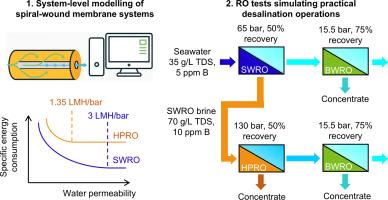量化高性能反渗透膜用于海水和高盐盐水淡化的潜力:从模块规模建模到实验评估
IF 9.8
1区 工程技术
Q1 ENGINEERING, CHEMICAL
引用次数: 0
摘要
高压反渗透(HPRO)是处理海水反渗透(SWRO)过程中产生的高盐盐水的一种有前途的技术。然而,目前关于HPRO膜在透水性和选择性方面的性能限制的指导很少。在这项研究中,我们模拟了RO压力容器内的流体动力学和质量传递,以探索改进膜性能带来的性能提升。我们的模拟表明,将HPRO膜的基准水渗透性(从0.45到1.35 Lm−2h−1bar−1)提高两倍,对于一个回收率为50%的HPRO工厂来说,可以减少23%的能耗或减少62%所需的压力容器数量。为了补充建模工作,我们在HPRO条件下对12个最先进的反渗透膜进行了实验评估,模拟SWRO盐水处理(130 bar, 70 g/L NaCl, 10 ppm硼)。在闭环测试中,膜的透水性值为0.34 ~ 0.87 Lm−2h−1bar−1,盐截留率为98.7 ~ 99.6%,硼截留率为77 ~ 93%。在反映实际操作的50%回收率测试中,达到饮用水标准证明是具有挑战性的,渗透浓度在708至1990 ppm NaCl和1.6-4.1 ppm硼之间,超过了饮用水的监管限制。为了解决这个问题,我们使用HPRO渗透液作为进料(2000 ppm NaCl, 4 ppm硼),以75%的回收率进行了二次微咸水反渗透。额外的第二道反渗透步骤成功地将渗透浓度降至75 ppm NaCl和0.35 ppm硼,达到饮用水质量标准。本研究有望为高盐盐水处理的HPRO系统设计提供指导。本文章由计算机程序翻译,如有差异,请以英文原文为准。

Quantifying the potential of high-performance RO membranes for seawater and hypersaline brine desalination: from module-scale modelling to experimental evaluation
High-pressure reverse osmosis (HPRO) is emerging as a promising technology for treating hypersaline brine from seawater RO (SWRO) processes. However, little guidance currently exists on the performance limits of HPRO membranes in terms of the water permeability and selectivity. In this study, we modelled fluid dynamics and mass transport within RO pressure vessels to explore performance gains from improved membrane properties. Our simulations indicate that tripling the baseline water permeability (from 0.45 to 1.35 Lm−2h−1bar−1) of HPRO membranes could reduce energy consumption by 23 % or cut the number of pressure vessels required by 62 %, for an HPRO plant operating at 50 % recovery. To complement the modelling work, we experimentally evaluated 12 state-of-the-art RO membranes under HPRO conditions simulating SWRO brine treatment (130 bar, 70 g/L NaCl, 10 ppm boron). In closed-loop tests, the membranes demonstrated water permeability values ranging from 0.34 to 0.87 Lm−2h−1bar−1, with 98.7–99.6 % salt rejection and 77–93 % boron rejection. In 50 % recovery tests reflecting real-world operation, achieving drinking water standards proved challenging, with permeate concentrations ranging from 708 to 1990 ppm NaCl and 1.6–4.1 ppm boron – exceeding regulatory limits for potable use. To address this, we conducted a second-pass brackish water RO at 75 % recovery, using the HPRO permeate as feed (2000 ppm NaCl, 4 ppm boron). The additional second-pass RO step successfully reduced permeate concentrations to 75 ppm NaCl and 0.35 ppm boron, meeting drinking water quality standards. This work is expected to provide guidance in terms of HPRO system design for hypersaline brine treatment.
求助全文
通过发布文献求助,成功后即可免费获取论文全文。
去求助
来源期刊

Desalination
工程技术-工程:化工
CiteScore
14.60
自引率
20.20%
发文量
619
审稿时长
41 days
期刊介绍:
Desalination is a scholarly journal that focuses on the field of desalination materials, processes, and associated technologies. It encompasses a wide range of disciplines and aims to publish exceptional papers in this area.
The journal invites submissions that explicitly revolve around water desalting and its applications to various sources such as seawater, groundwater, and wastewater. It particularly encourages research on diverse desalination methods including thermal, membrane, sorption, and hybrid processes.
By providing a platform for innovative studies, Desalination aims to advance the understanding and development of desalination technologies, promoting sustainable solutions for water scarcity challenges.
 求助内容:
求助内容: 应助结果提醒方式:
应助结果提醒方式:


